
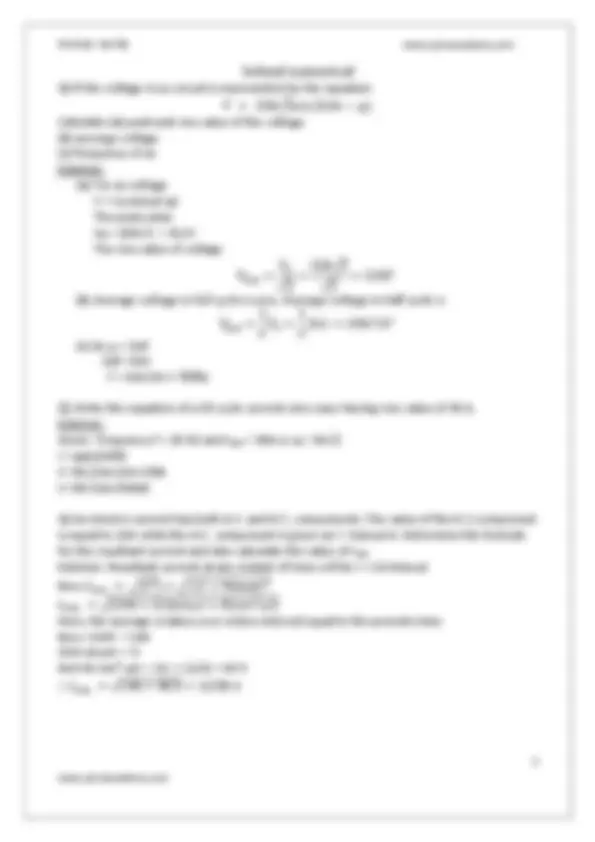
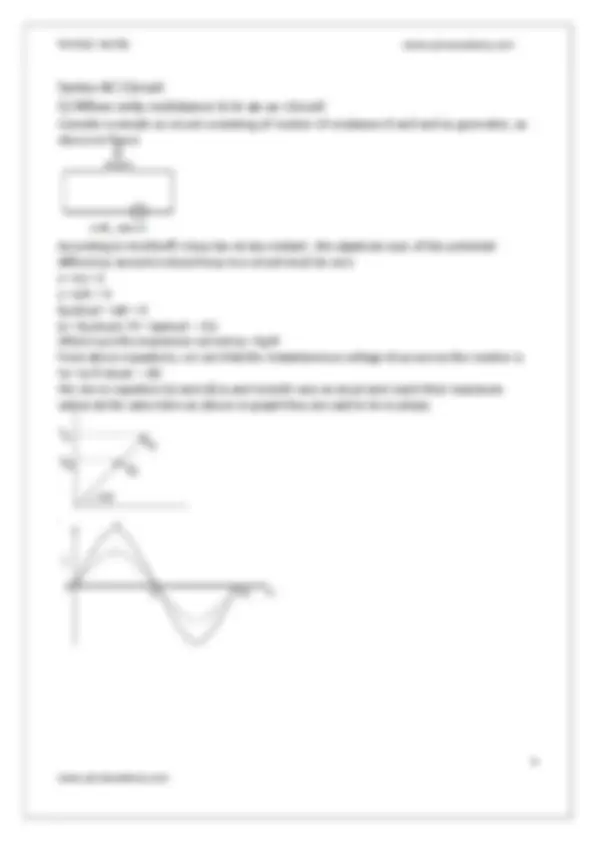
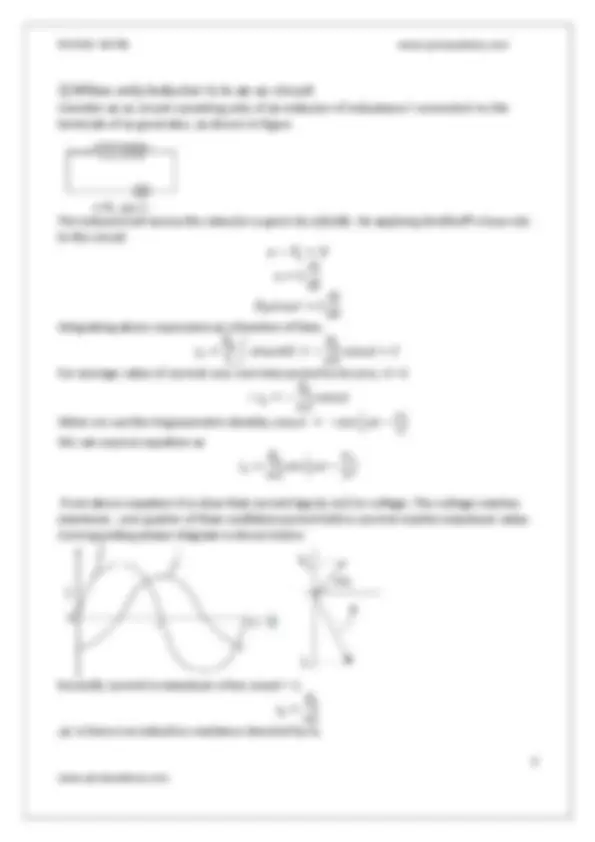
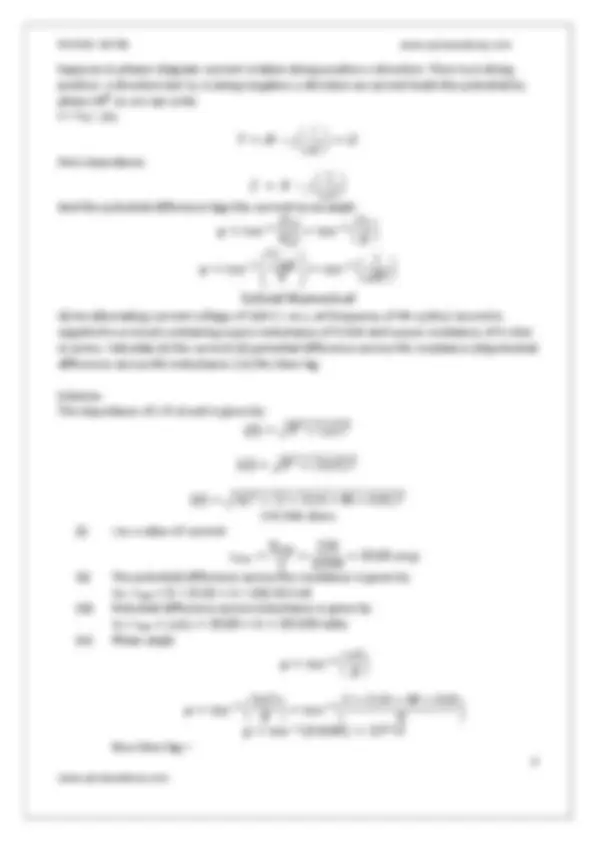
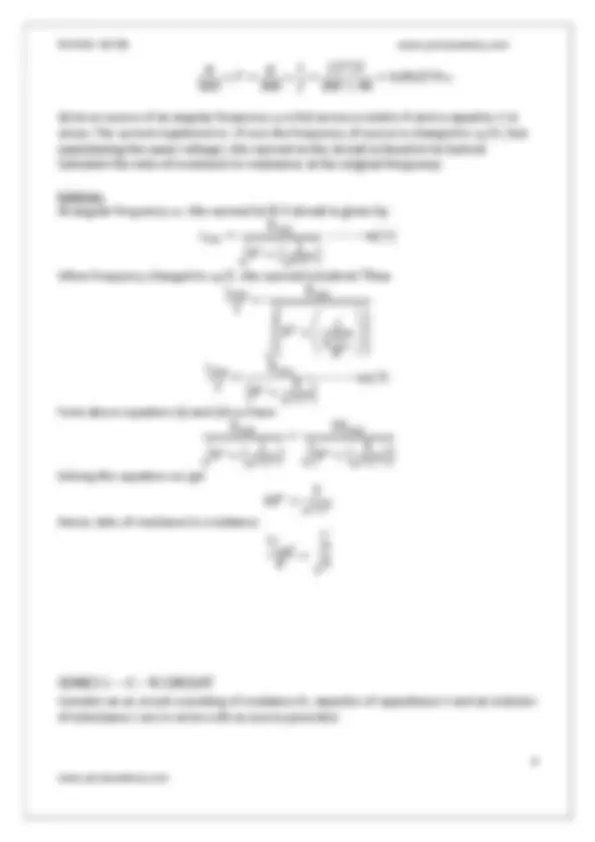
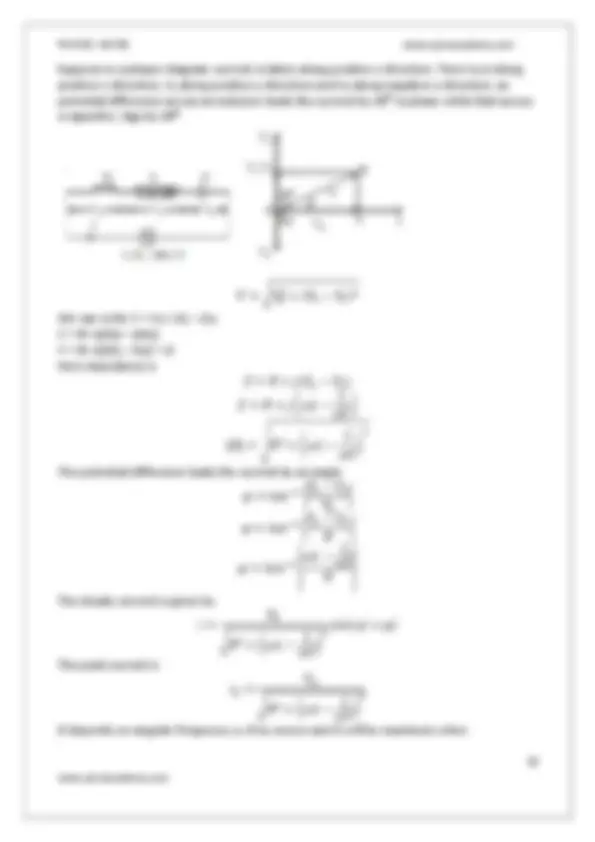
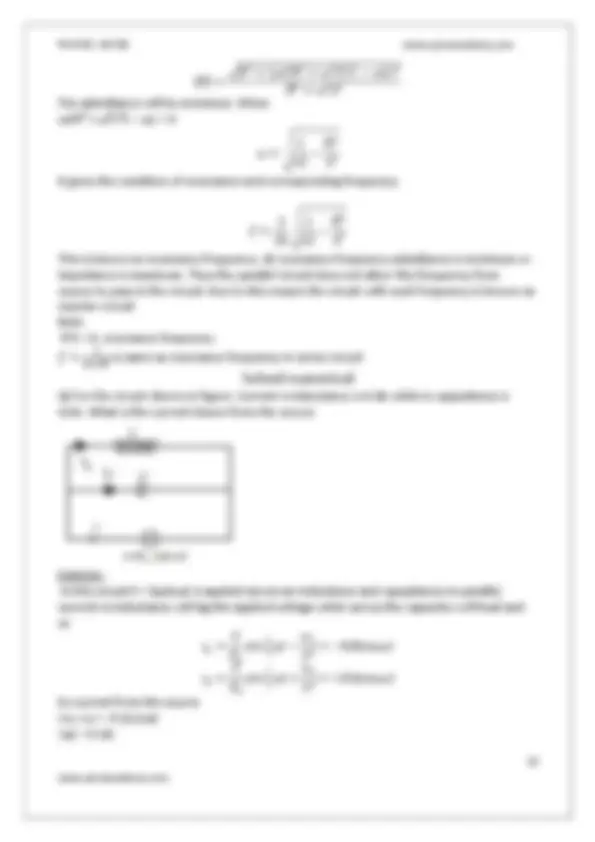
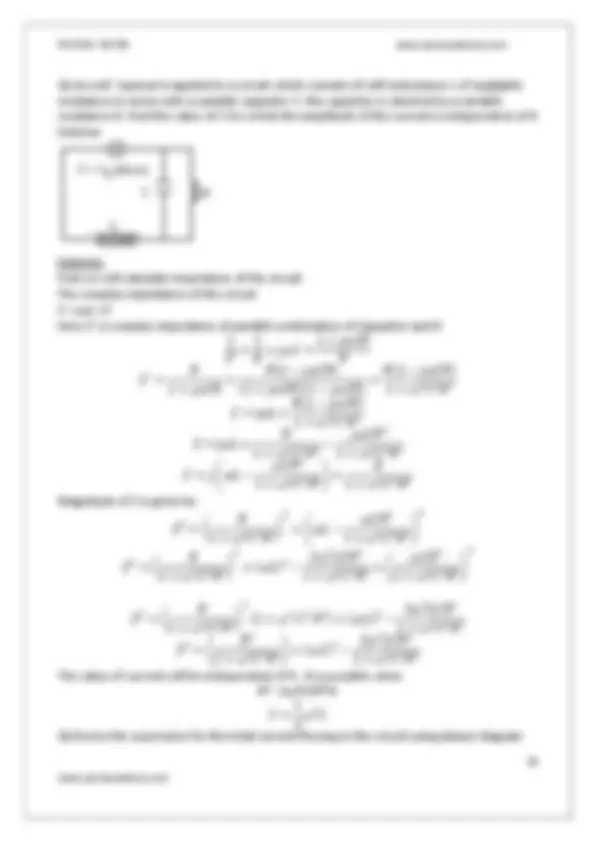
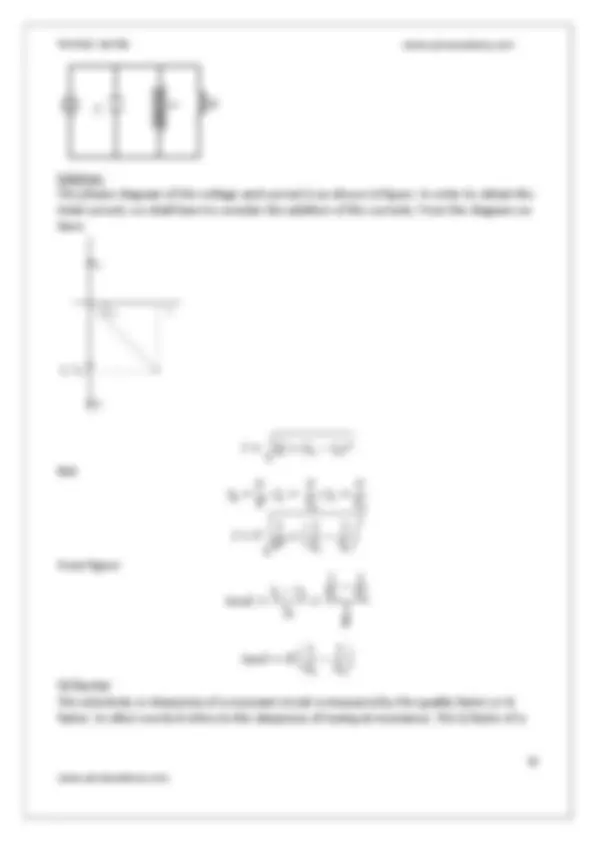
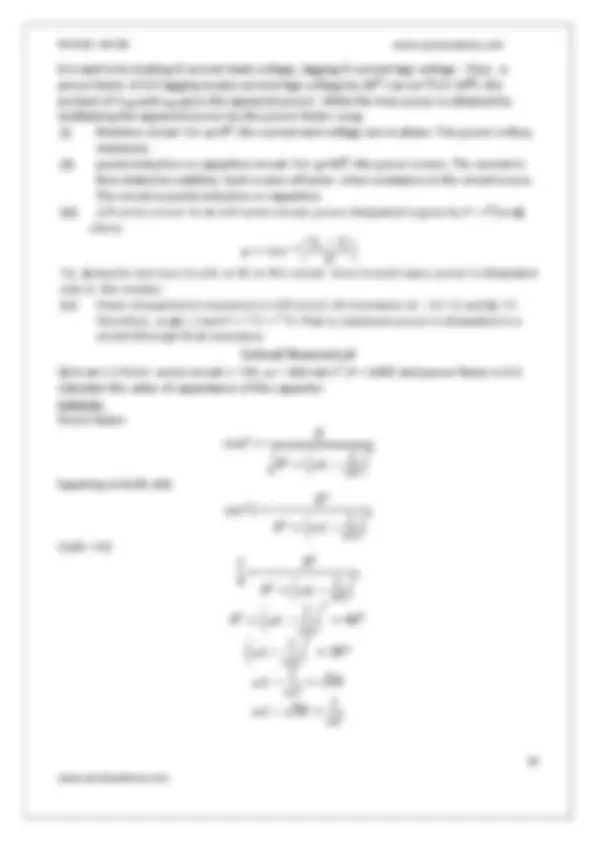
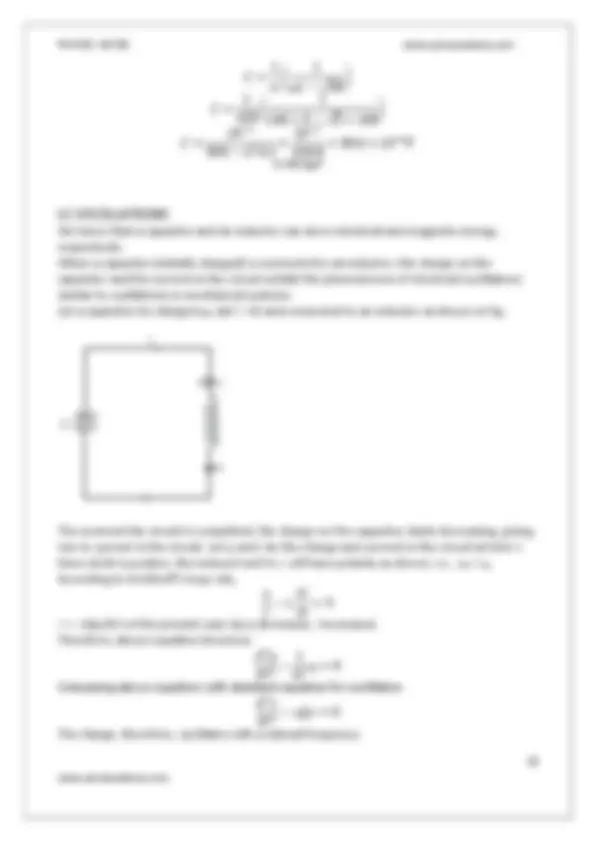
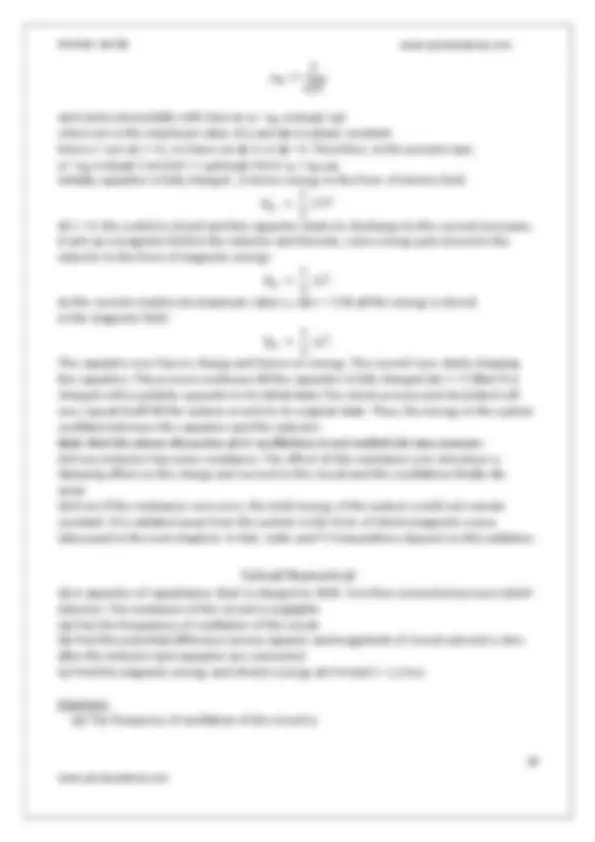
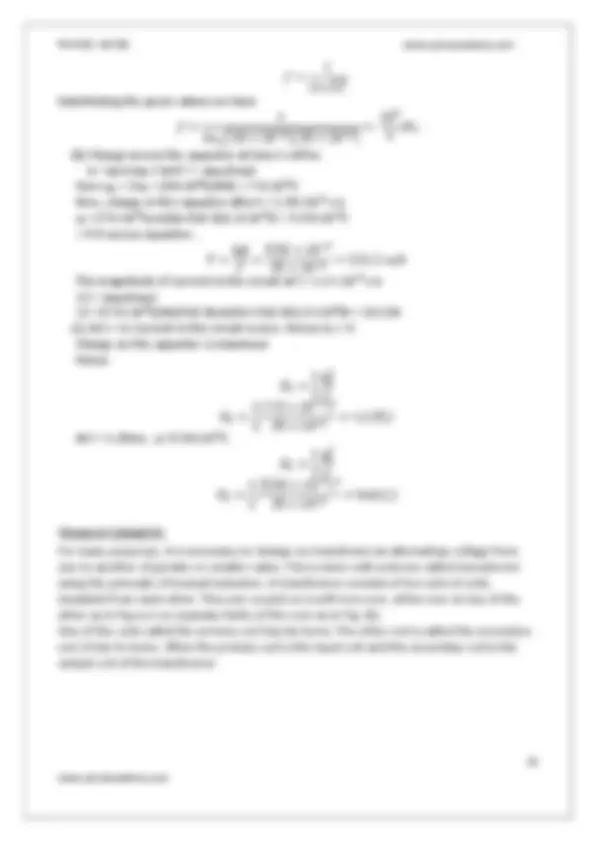

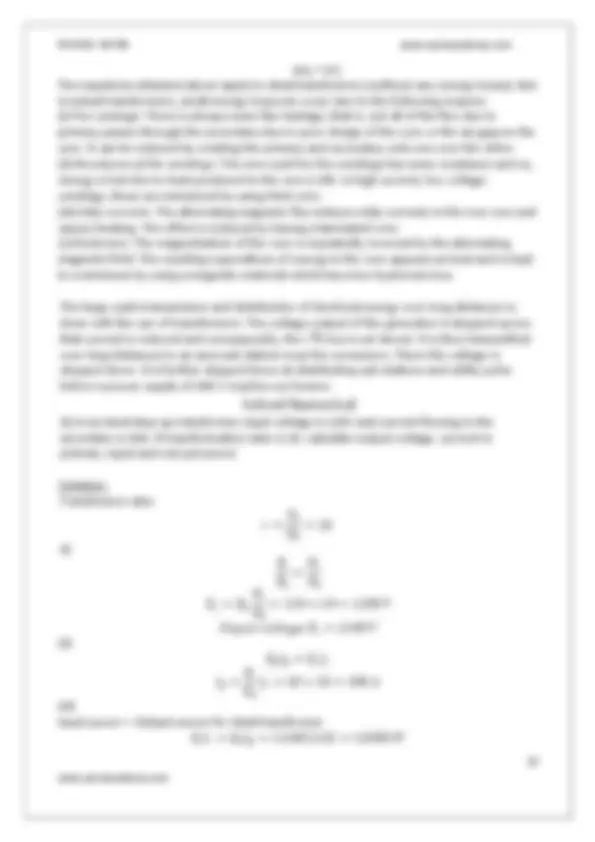


Study with the several resources on Docsity

Earn points by helping other students or get them with a premium plan


Prepare for your exams
Study with the several resources on Docsity

Earn points to download
Earn points by helping other students or get them with a premium plan
Community
Ask the community for help and clear up your study doubts
Discover the best universities in your country according to Docsity users
Free resources
Download our free guides on studying techniques, anxiety management strategies, and thesis advice from Docsity tutors
Basic fundamentals regarding AC system.
Typology: Exercises
1 / 23

This page cannot be seen from the preview
Don't miss anything!
















1
As we have seen earlier a rotating coil in a magnetic field, induces an alternating emf and hence an alternating current. Since the emf induced in the coil varies in magnitude and direction periodically, it is called an alternating emf. The significance of an alternating emf is that it can be changed to lower or higher voltages conveniently and efficiently using a transformer. Also the frequency of the induced emf can be altered by changing the speed of the coil. This enables us to utilize the whole range of electromagnetic spectrum for one purpose or the other. For example domestic power in India is supplied at a frequency of 50 Hz. For transmission of audio and video signals, the required frequency range of radio waves is between 100 KHz and 100 MHz. Thus owing to its wide applicability most of the countries in the world use alternating current.
Since alternating current varies continuously with time, its average value over one complete cycle is zero. Hence its effect is measured by rms value of a.c.
The rms value of alternating current is defined as that value of the steady current, which when passed through a resistor for a given time, will generate the same amount of heat as generated by an alternating current when passed through the same resistor for the same time. The rms value is also called effective value of an a.c. and is denoted by Irms when an alter- nating current i=Io sin ωt flows through a resistor of resistance R, the amount of heat produced in the resistor in a small time dt is dH = i^2 R dt. We know that alternating current is given I = i 0 sinωt
The total amount of heat produced in the resistance in one complete cycle is
𝐻 = ∫ 𝑖^2
𝑇
0
𝑇
0
𝑇
0
𝑇
0
𝑇
0
As ∫ 𝑐𝑜𝑠2𝜔𝑡𝑑𝑡 𝑇 0 = 0
2
But this heat is also equal to the heat produced by rms value of AC in the same resistor (R) and in the same time (T), 𝐻 = 𝐼𝑟𝑚𝑠^2 𝑅𝑇 Thus
𝐼𝑟𝑚𝑠^2 𝑅𝑇 =
We can calculate rms value as root mean square value : The mean value or average value of ac over time T is given by
𝑖𝑟𝑚𝑠^2 =
𝑇 0 ∫ 𝑑𝑡
𝑇 0
𝑇 0 ∫ 𝑑𝑡
𝑇 0
𝑖𝑟𝑚𝑠^2 =
𝑇 0 2𝑇
As (^) ∫ 𝑐𝑜𝑠2𝜔𝑡𝑑𝑡 𝑇 0 = 0
Similarly 𝐸𝑟𝑚𝑠 =
4
Consider a simple ac circuit consisting of resistor of resistance R and and ac generator, as shown in figure
According to Kirchhoff’s loop law at any instant , the algebraic sum of the potential difference around a closed loop in a circuit must be zero e – VR = 0 e – IR R = 0 E 0 sinωt – IRR = 0 IR = E 0 sinωt / R = I 0 sinωt ---(1) Where I 0 is the maximum current I 0 = E 0 /R From above equations, we see that the instantaneous voltage drop across the resistor is VR = IO R sinωt ---(2) We see in equation (1) and (2) IR and VR both vary as sinωt and reach their maximum values at the same time as shown in graph they are said to be in phase.
5
Consider an ac circuit consisting only of an indiuctor of inductance l connected to the termicals of ac generator, as shown in figure
The induced emf across the inductor is given by L(di/dt). On applying Kirchhoff’s loop rule to the circuit 𝑒 − 𝑉𝐿 = 0 𝑒 = 𝐿
Integrating above expression as a function of time
𝑖𝐿 =
For average value of current over one time period to be zero, C= 0
∴ 𝑖𝐿 = −
When we use the trigonometric identity 𝑐𝑜𝑠𝜔𝑡 = −𝑠𝑖𝑛 (𝜔𝑡 − 𝜋 2 )
We can express equation as
𝑖𝐿 =
From above equation it is clear that current lags by π/2 to voltage. The voltage reaches maximum , one quarter of than oscillation period before current reaches maximum value. Corresponding phasor diagram is shown below
Secondly current is maximum when cosωt = 1
𝑖 0 =
ωL is known as inductive reactance denoted by XL
7
Now consider an ac circuit consisting of a resistor or resistance R and an inductor of inductance L in series with an ac source generator
Suppose in phasor diagram, current is taken along positive direction. The VR is also along positive x-direction as there is no phase difference between iR and VR. While VL will be along y direction as we know that current lags behind the voltage by 90O So we can write V = VR + jVL V = iRR + j(iXL) V= iZ
Here Z = R + jXL = R + j(ωL) is called as impedance of the circuit. Impedance plays the same role in ac circuit as the ohmic resistance does in DC circuit. The modulus of impedance is
|𝑍| = √𝑅^2 + (𝜔𝐿)^2 The potential difference leads the current by an angle
𝜑 = 𝑡𝑎𝑛−1^ |
Now consider an ac circuit consisting of resistance R and a capacitor of capacitance C in series with an ac source generator
8
Suppose in phasor diagram current is taken along positive x-direction. Then VR is along positive x-direction but VC is along negative y-direction as current leads the potential by phase 90O^ so we can write V = VR – jVC
𝑉 = 𝑖𝑅 − 𝑗 (
Here impedance
𝑍 = 𝑅 − 𝑗 (
And the potential difference lags the current by an angle
𝜑 = 𝑡𝑎𝑛−1^ |
Q) An alternating current voltage of 220 V r.m.s. at frequency of 40 cycles/ second is supplied to a circuit containing a pure inductance of 0.01H and a pure resistance of 6 ohm in series. Calculate (i) the current (ii) potential difference across the resistance (iii)potential difference across the inductance ( iv) the time lag
Solution The impedance of L-R circuit is given by
|𝑍| = √𝑅^2 + (𝜔𝐿)^2
Z=6.504 ohms (i) r.m.s value of current 𝑖𝑟𝑚𝑠 =
(ii) The potential difference across the resistance is given by VR = irms × R = 33.83 × 6 = 202.98 Volt (iii) Potential difference across inductance is given by VL = irms × (ωL) = 33.83 × 6 = 202.98 volts (iv) Phase angle 𝜑 = 𝑡𝑎𝑛−1^ (
Now time lag =
10
Suppose in a phasor diagram current is taken along positive x-direction. Then VR is along positive x-direction, VL along positive y-direction and VC along negative y-direction, as potential difference across an inductor leads the current by 90O^ in phase while that across a capacitor, lags by 90O
We can write V = VR + jVL – jVC V = iR +j(iXL) – j(iXC) V = iR +j[i(XL – XC)] = iZ Here impedance is 𝑍 = 𝑅 + 𝑗(𝑋𝐿 − 𝑋𝐶 ) 𝑍 = 𝑅 + 𝑗 (𝜔𝐿 −
2
The potential difference leads the current by an angle
𝜑 = 𝑡𝑎𝑛−1^ |
The steady current is given by
𝑖 =
2
The peak current is
𝑖 0 =
2
It depends on angular frequency ω of ac source and it will be maximum when
11
And corresponding frequency is
This frequency is known as resonant frequency of the given circuit. At this frequency peak
current will be 𝑖 0 = 𝑉 0 𝑅 This resistance R in the LCR circuit is zero, the peak current at resonance is 𝑖 0 = 𝑉 0 𝑅 It means, there can be a finite current in pure LC circuit even without any applied emf. When a charged capacitor is connected to pure inductor
This current in the circuit is at frequency 𝑓 = 1 2𝜋 √^
1 𝐿𝐶
Q) A resistor of resistance R, an inductor of inductance L and a capacitor of capacitance C all are connected in series with an a.c. supply. The resistance of R is 16 ohm. And for a given frequency, the inductive reactance of L is 24 ohms and capacitive reactance of C is 12 ohms. If the current in circuit is 5amp, find (a) The potential difference across R, L and C (b) the impedance of the circuit (c) the voltage of ac supply (d) Phase angle
Solution: (a) Potential difference across resistance VR = iR = 5×16 =80 volt Potential difference across inductance VL = i × (ωL) = 5 × 24 = 120 volt Potential across condenser VC = i × (1/ωC) = 5 × 12 = 60 volts (b) Impedance
2
(c) The voltahe of ac supply is given by V = iZ = 5 ×20 = 100 volt
(c) Phase angle
13
The admittance will be minimum. When ωCR^2 + ω^3 L^2 C – ωL = 0
It gives the condition of resonance and corresponding frequency
This is known as resonance frequency. At resonance frequency admittance is minimum or impedance is maximum. Thus the parallel circuit does not allow this frequency from source to pass in the circuit. Due to this reason the circuit with such frequency is known as rejecter circuit Note If R = 0, resonance frequency
𝑓 = 1 2𝜋√𝐿𝐶 is same as resonance frequency in series circuit
Q) For the circuit shown in figure. Current is inductance is 0.8A while in capacitance is 0.6A. What is the current drawn from the source
Solution: In this circuit E = E 0 sinωt is applied across an inductance and capacitance in parallel, current in inductance will lag the applied voltage while across the capacitor will lead and so
𝑖𝐿 =
So current from the source i=iL + iC = -0.2cosωt |i 0 | = 0.2A
14
Q) An emf V 0 sinωt is applied to a circuit which consists of self-inductance L of negligible resistance in series with a variable capacitor C. the capacitor is shunted by a variable resistance R. Find the value of C for which the amplitude of the current is independent of R Solution
Solution: First we will calculate impedance of the circuit The complex impedance of the circuit Z = jωL +Z’ Here Z’ is complex impedance of parallel combination of Capacitor and R 1 𝑍′
𝑍 = jωL +
𝑍 = jωL +
𝑍 = 𝑗 (ωL −
Magnitude of Z is given by
𝑍^2 = (
2
2
2
2
2 (1 + 𝜔^2 𝐶^2 𝑅^2 ) + (𝜔𝐿)^2 −
The value of current will be independent of R. It is possible when R^2 - 2ω^2 LCR^2 = 𝐶 =
Q) Derive the expression for the total current flowing in the circuit using phaser diagram
16
series resonant circuit is defined as the ratio of the voltage across a coil or capacitor to the applied voltage.
𝑄 =
Voltage across L = I ωoL …(2) where ωo is the angular frequency of the a.c. at resonance. The applied voltage at resonance is the potential drop across R, because the potential drop across L is equal to the drop across C and they are 180o^ out of phase. Therefore they cancel out and only potential drop across R will exist. Applied Voltage = IR ...(3) Substituting equations (2) and (3) in equation (1)
𝑄 =
I ωoL IR
ωoL R 𝑄 =
Q is just a number having values between 10 to 100 for normal frequencies. Circuit with high Q values would respond to a very narrow frequency range and vice versa. Thus a circuit with a high Q value is sharply tuned while one with a low Q has a flat resonance. Q- factor can be increased by having a coil of large inductance but of small ohmic resistance. Current frequency curve is quite flat for large values of resistance and becomes more sharp as the value of resistance decreases. The curve shown in graph is also called the frequency response curve.
Sharpness of resonance The amplitude of the current in the series LCR circuit is given by
𝑖𝑚𝑎𝑥 =
2
and is maximum when ω = ω 0 = 1/√(LC) The maximum value is imax = Vmax/R For values of ω other than ω0, the amplitude of the current is less than the maximum value. Suppose we choose a value of ω for which the current amplitude is 1/ √2 times its maximum value. At this value, the power dissipated by the circuit becomes half. From the curve in Fig. ,we see that there are two such values of ω, say, ω 1 and ω 2 , one greater and the other smaller than ω 0 and symmetrical about ω 0. We may
17
write ω 1 = ω 0 + Δω ω 2 = ω 0 – Δω The difference ω 1 – ω 2 = 2Δω is often called the bandwidth of the circuit. The quantity (ω 0 / 2Δω) is regarded as a measure of the sharpness of resonance. The smaller the Δω, the sharper or narrower is the resonance. We see from Fig. that if the resonance is less sharp, not only is the maximum current less, the circuit is close to resonance for a larger range Δω of frequencies and the tuning of the circuit will not be good. So, less sharp the resonance, less is the selectivity of the circuit or vice versa.
Value of ∆𝜔 = 𝑅 2𝐿 we see that if quality factor is large, i.e., R is low or L is large, the circuit is more selective.
In case of steady current the rate of doing work is given by, P = VI In an alternatin circuit, current and voltage both vary with time, so the work done by the source in time intrerval dt is given by dw = Vidt Suppose in an ac, the current is leading the voltage by an angle φ. Then we can write V = Vmsinωt and I = imsin(ωt+φ) dw = Vm imsinωt sin(ωt+φ)dt dw = Vm im (sin^2 ωtcosφ +sinωtcosωtsinφ) dt The total work done in a complete cycle is
𝑊 = 𝑉𝑚𝑖𝑚𝑐𝑜𝑠𝜑 ∫ 𝑠𝑖𝑛^2
𝑇
0
𝑇
0 𝑊 =
𝑇
0
𝑇
0 𝑊 =
The average power delivered by the source is, therefore P=W/T
𝑃 =
This can also be written as, P = I^2 Zcosφ Here, Z is impedance, the term cosφ is known as power factor
19
C=30.6μF
We know that a capacitor and an inductor can store electrical and magnetic energy, respectively. When a capacitor (initially charged) is connected to an inductor, the charge on the capacitor and the current in the circuit exhibit the phenomenon of electrical oscillations similar to oscillations in mechanical systems. Let a capacitor be charged qm (at t = 0) and connected to an inductor as shown in Fig..
The moment the circuit is completed, the charge on the capacitor starts decreasing, giving rise to current in the circuit. Let q and i be the charge and current in the circuit at time t. Since d i /d t is positive, the induced emf in L will have polarity as shown, i.e., vb < va. According to Kirchhoff’s loop rule, 𝑞 𝐶
i = – (d q /d t ) in the present case (as q decreases, i increases). Therefore, above equation becomes: 𝑑^2 𝑞 𝑑𝑡^2
Comparing above equation with standard equation for oscillation 𝑑^2 𝑥 𝑑𝑡^2
The charge, therefore, oscillates with a natural frequency
20
and varies sinusoidally with time as q = qm cos(ω 0 t +φ) where qm is the maximum value of q and φ is a phase constant. Since q = qm at t = 0, we have cos φ =1 or φ = 0. Therefore, in the present case, q = qm cos(ω 0 t ) current I = imsin(ω 0 t ) here im = qm ω 0 Initially capacitor is fully charged , it stores energy in the form of electric field
𝑈𝐸 =
At t = 0, the switch is closed and the capacitor starts to discharge As the current increases, it sets up a magnetic field in the inductor and thereby, some energy gets stored in the inductor in the form of magnetic energy:
𝑈𝐵 =
As the current reaches its maximum value im , (at t = T /4) all the energy is stored in the magnetic field:
𝑈𝐵 =
The capacitor now has no charge and hence no energy. The current now starts charging the capacitor, This process continues till the capacitor is fully charged (at t = T /2But it is charged with a polarity opposite to its initial state The whole process just described will now repeat itself till the system reverts to its original state. Thus, the energy in the system oscillates between the capacitor and the inductor. Note that the above discussion of LC oscillations is not realistic for two reasons : (i) Every inductor has some resistance. The effect of this resistance is to introduce a damping effect on the charge and current in the circuit and the oscillations finally die away. (ii) Even if the resistance were zero, the total energy of the system would not remain constant. It is radiated away from the system in the form of electromagnetic waves (discussed in the next chapter). In fact, radio and TV transmitters depend on this radiation.
Q) A capacitor of capacitance 25μF is charged to 300V. It is then connected across a 10mH inductor. The resistance of the circuit is negligible (a) Fins the frequaency of oscillation of the circuit (b) Find the potential difference across capacior and magnitude of circuit cutrrent 1.2ms after the inductor and capacitor are connected (c) Find the magnetic energy and electric energy at t=0 and t = 1.2 ms.
Solutions: (a) The frequency of oscillation of the circuit is